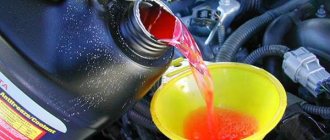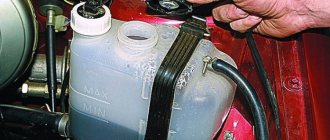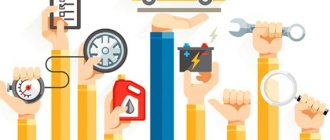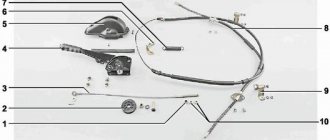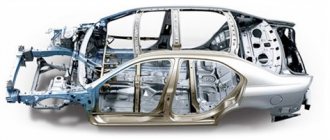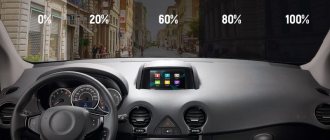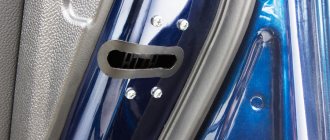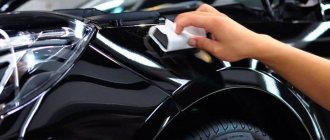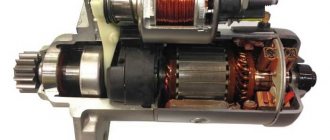Each vehicle, depending on its use, must undergo certain types of maintenance (service, daily, seasonal), as well as follow a vehicle maintenance schedule. Their goal is to diagnose and eliminate minor malfunctions associated with the operation of the vehicle, as well as prevent future breakdowns.
It should be clarified that maintenance is more of a preventative measure rather than a repair. Don’t forget that there are the cheapest and most expensive cars to maintain.
Depending on the frequency of execution, maintenance is divided into:
— seasonal (SO); — second (TO-2); — first (TO-1); — daily (EO); - service.
What consumables are needed for vehicle maintenance?
Consumables include oils, fluids for braking and cooling systems, filters, timing belts, generators and secondary mechanisms. The most popular consumables:
- Gasoline, air, oil, cabin filters. They need to be changed every 10–15 thousand kilometers.
- Timing belts, generator, power steering and air conditioning. The timing chain has approximately the same service life as the belt. The rollers are changed along with the belt or chain.
- Spark plugs wear out over time - the electrodes become smaller, the spark loses its power.
- Liquid in the cooling system.
- Engine oil.
- Transmission oil.
- If there is severe wear, the following components are replaced: oil pump, pump, starter, generator, tires, bearings (wheel drive, gearbox shafts, engine), valves, etc.
Moreover, this is an incomplete list; for each car model there are special maintenance cards, which indicate when and what changes. But how do you know if a spare part fits your car? Check the vehicle and part manufacturer's recommendations. Supplies labels sometimes indicate which makes and models they apply to.
The most reliable way to independently choose the right consumables for maintenance is to use the car’s VIN to find the necessary consumables in the original catalog of the car manufacturer. This method requires certain technical knowledge about the structure of the car. If you do not have such skills, then it is better to use the maintenance catalog, in which we have collected all the most popular consumables for most cars. If you don’t have the time or desire to rummage through catalogs, then you can simply leave a request to the expert to select spare parts. Experts will select original consumables and high-quality analogues.
Mileage inspection period
The Volkswagen car (TO-2, the list of works is indicated in the article) requires regular follow-up inspection, like most types of vehicles. Among the technical inspections we note the following:
- TO-3 is carried out after 45 thousand kilometers and includes work typical for the first technical inspection.
- TO-4 is performed after four years of vehicle operation or 60 thousand kilometers. The inspection includes the work provided for the first and second inspection, as well as replacing spark plugs, checking the condition of the timing chain or belt mechanism, checking the tensioner and oil pump device.
- TO-5 is an analogue of the first maintenance, carried out after 75 thousand km.
- TO-6 - after 90 thousand km, work similar to TO-1 and 2 is performed.
- TO-7, 8, 9, 10 are produced after 105, 120, 135 and 150 thousand kilometers, respectively.
The difference between maintenance and car repair
If repair is a necessary measure and must eliminate breakdowns, maintenance is a preventive measure. Roughly speaking, if a car is in an accident, it needs repairs. If the car passed the maintenance on time, the brakes were checked, an accident was avoided, there is no need for repairs.
The purpose of maintenance is to prevent breakdowns, prevent premature wear, and eliminate minor breakdowns that threaten repair. Types of vehicle maintenance and repair can be different and differ in level of complexity.
During the maintenance process, the following are carried out: diagnostics, checking fasteners, lubrication, refueling, adjustment, etc. A distinctive feature of scheduled maintenance is that machine units, as a rule, are not disassembled, and individual components are not removed.
In case of repair, on the contrary, technical components are disassembled, removed and repaired or replaced.
During maintenance, oil, spark plugs, filters, and other consumables are usually changed.
How often should you have your car inspected?
The timing of the technical inspection and the validity of the diagnostic card depend on the year of manufacture of the car.
The frequency of maintenance depends on the class of the machine and the purpose for which it is used:
- periodicity is 2 years for cars if 3 to 7 years have passed since its production (the year of manufacture is the date indicated in the vehicle passport).
- after 1 year for cars, if more than 7 years have passed since production , taking into account the year of manufacture.
Regardless of the year of manufacture, the following vehicles require maintenance every year:
- A truck with a maximum weight of 3.5 tons.
- All cars equipped with special signals (light and sound).
- “Training” vehicles used for driving training in driving schools.
Once every 6 months, regardless of the year of production, maintenance is carried out (clause 1, part 1, article 15 of Law dated 07/01/2011 N 170-FZ):
- Passenger taxi.
- Bus.
- A truck with the ability to transport passengers, where the number of seats is more than 8. The driver's seat is not taken into account.
- Special vehicles, as well as their trailers, in which dangerous goods are transported.
If desired, the vehicle owner can undergo maintenance until the previous coupon expires. The owner of the car cannot be denied this right.
Vehicle inspection times by year
| Vehicle service life (from the year of vehicle manufacture) | 1 year | 2 years | 3 years | 4 years | 5 years | 6 years | 7 years | from 8 years | ||||||||
| months since the beginning of the year | 6 | 12 | 6 | 12 | 6 | 12 | 6 | 12 | 6 | 12 | 6 | 12 | 6 | 12 | 6 | 12 |
| Vehicle type | ||||||||||||||||
| Taxi | X | X | X | X | X | X | X | X | X | X | X | X | X | X | X | X |
| Buses | X | X | X | X | X | X | X | X | X | X | X | X | X | X | X | X |
| Trucks designed and equipped for the transport of passengers, with a number of seats exceeding 8 (excluding the driver's seat) | X | X | X | X | X | X | X | X | X | X | X | X | X | X | X | X |
| Special vehicles and their principles, designed and equipped for the transportation of hazardous cargo | X | X | X | X | X | X | X | X | X | X | X | X | X | X | X | X |
| Trucks with a permissible maximum weight of more than 3500 kg. (except for the vehicles specified in clause 3) | X | X | X | X | X | X | X | X | ||||||||
| Vehicles equipped in accordance with the legislation of the Russian Federation with devices for supplying special light and sound signals (except for vehicles specified in clauses 1-4) | X | X | X | X | X | X | X | X | ||||||||
| Vehicles intended for training in driving vehicles (except for vehicles specified in clauses 1-4) | X | X | X | X | X | X | X | X | ||||||||
| Passenger cars with a permissible maximum weight of up to 3500 kg. (except for the vehicles specified in clauses 1-7) | X | X | X | X | ||||||||||||
| Trucks with a permissible maximum weight of up to 3500 kg. (except for the vehicles specified in clauses 1-7) | X | X | X | X | ||||||||||||
| Trailers and semi-trailers with a permissible maximum weight of up to 3500 kg. (except for vehicles specified in clauses 1-7) | X | X | X | X | ||||||||||||
| Motor vehicles | X | X | X | X | ||||||||||||
Types of car maintenance
The volume and content of operations included in car maintenance are determined by the make and model of the car, as well as factors such as current mileage, seasonality and reaching a certain shelf life if the car has not been used during this period.
Particular importance was attached to compliance with maintenance regulations in Soviet times, when, on the one hand, cars were not as sophisticated and reliable as they are now, and on the other hand, discipline in the operation of vehicles was maintained (especially in organizations).
The rule of inspecting a vehicle before leaving for a trip and eliminating any identified deficiencies is mandatory for every driver and vehicle. And such a requirement, especially for trucks and buses, is completely justified: transportation of people and large cargo requires increased safety measures.
We recommend: Do-it-yourself replacement of a light bulb in a fog light - how to select and change a lamp
The classification of types of maintenance in Russia has been preserved since Soviet times in the “Planned and preventive system of vehicle maintenance” and includes the following main positions:
- daily vehicle maintenance;
- first vehicle maintenance – TO-1;
- second vehicle maintenance – TO-2;
- seasonal vehicle maintenance.
Manufacturers of modern passenger cars have somewhat modified the numbering and frequency of maintenance:
- The numbering according to the classification of TO-2, carried out, as a rule, at equal intervals of time, has become continuous: from TO-1 to TO-10 or even TO-12.
- For a number of passenger car manufacturers, the need to carry out maintenance according to the TO-1 classification has disappeared, and for some, this operation remains with the code name TO-0.
That is, for passenger cars, the types and numbering of maintenance may look like this:
- daily maintenance;
- zero maintenance – TO-0;
- periodic maintenance (numbered) – TO-1…TO-10 (TO-12);
- seasonal maintenance.
The maintenance schedule, service intervals and content of operations for each type of maintenance are determined by the vehicle manufacturer and are indicated in the service book.
For TO-0 (TO-1 according to the generally accepted classification), the upper mileage limit is, as a rule, 2-2.5 thousand km. Service intervals between subsequent maintenance usually range from 10 to 20 thousand km.
Daily vehicle maintenance
Daily maintenance - ETO (for passenger cars, rather, an inspection before a trip) involves control and inspection operations of the main components and assemblies of the car, primarily those that affect safety on the road. In this case they check:
- inspection - presence of leaks in the brake system, power steering, engine (coolant, engine oil), transmission;
- inspection - fluid levels in tanks and crankcases of main components and assemblies. If necessary, top up;
- inspection and testing - operation of electrical equipment, gauges and dashboard indicators;
- inspection - the condition of the tires. If necessary, inflate (see tire pressure tables);
- testing - starting the engine, testing when starting the brakes, steering, clutch, gearbox.
First maintenance
The first maintenance of TO-1 includes operations included in daily maintenance, as well as additionally the following work:
- body wash, interior cleaning;
- control, diagnostic and inspection work (in addition to ETO inspection): checking the effectiveness of braking, parking brake, brake drive, free play of the steering wheel, clearances of the steering mechanism, protective covers of chassis parts, checking the condition of springs, levers, rods and suspension struts, free movement of clutch and brake pedals, tension of drive belts of engine attachments;
- adjustment work: free play of pedals, tension of drive belts, parking brake, free play of steering wheel, clearance of steering drive connections, carburetor (for carburetor engines);
- fastening (check and tighten if necessary): mounting the engine, gearbox, steering mechanism, steering rods, swing arms, wheel rims, exhaust system parts, brake mountings;
- refueling stations: changing the engine oil (with replacing the oil filter);
- electrical: checking and, if necessary, cleaning the battery and electrical equipment from dust and dirt, checking the condition of insulation, replacing, if necessary, burnt-out lamps or fuses.
Second maintenance
The second technical maintenance - TO-2 includes operations included in TO-1, as well as additional work on in-depth diagnostics of the main systems, components and assemblies of the vehicle.
In addition to a larger volume of control and diagnostic work during TO-2, more refueling operations occur. In addition to changing the engine oil, depending on the mileage or storage period, the following changes:
- Coolant,
- Brake fluid,
- Gearbox oil
- Oil in the hydraulic system,
- Axle oil (for trucks and passenger all-wheel drive vehicles).
For a given mileage, TO-2 regulates the mandatory replacement of certain elements. For passenger cars this is:
- Fuel filters,
- Air filters,
- Cabin filters,
- Transmission filter (if it is automatic),
- Spark plug,
- Timing belt and rollers (if timing belt drive) and additional equipment.
Fastening work during TO-2 is also carried out to a greater extent than during TO-1. These include checking fastening tightness:
- Cylinder heads,
- radiator,
- Timing covers,
- Engine sump,
- Intake and exhaust manifolds,
- fuel tank,
- Rear axle gear covers,
- Door locks and hinges.
Among the regulatory works, it is necessary to note the regulation:
- Engine valves,
- Timing drive force tension,
- The gap between the brake pads and discs,
- Front wheel hub bearing clearance.
Specific TO-2 operations depend on the make, model and service interval recommended by a particular automaker.
Seasonal Maintenance
Seasonal maintenance (SM) is carried out to prepare the vehicle for use in the upcoming winter or summer season.
The fact is that a sharp change in ambient temperature affects the performance of parts, components and assemblies of the car: in the cold season, for example, lubricants with lower viscosity are required, the starting ability of the battery is reduced, it is necessary to ensure trouble-free operation of the heating system, and wheel traction deteriorates with road surface.
Typically, car enthusiasts try to combine seasonal maintenance, which includes changing tires as the main operation, with one of the scheduled scheduled maintenance (according to the classification of the scheduled maintenance system TO-2).
Let's sum it up
So we reviewed with you the list of TO-1 works and many other interesting points. In addition to TO-1 and TO-2, do not forget about seasonal and daily maintenance. Every driver should check the fluid levels in the lubrication, cooling and brake systems before driving. It is clear that the brakes play a huge role, but the cooling system or engine lubrication is also fully responsible for the proper operation of the power unit. If you do not carry out maintenance of the vehicle, and some serious damage occurs due to your fault, then you will have to restore the car at your own expense.
In general, maintenance is once a year or every 15 thousand km. must be done. Unfortunately, in Russia there is not the best opinion about dealer service. Often, unscrupulous employees increase price tags, which leads to large financial costs. In Europe, prices for scheduled maintenance are somewhat lower. This is despite the fact that only the necessary adjustment and lubrication work is carried out there. Also, they undertake to make cars under warranty much more often, although this is required in European countries less often than in Russia.
Mandatory warranty maintenance
As a rule, the dealer guarantees servicing of the sold car only if the clauses of the concluded purchase and sale agreement are observed. That is, do not modify the car yourself and comply with other restrictions (the terms of the contract depend on the specific dealer). Compliance with these conditions allows you to avoid unnecessary time costs. However, there are nuances.
IMPORTANT! In many cases, dealers offer to enter into an agreement on obviously illegal terms in order to increase their profits. First of all, this concerns limiting the area of their responsibility and reducing the rights of the buyer. Each specific case must be considered separately. For example, by law, the dealer is required to prove that the installation of a radio resulted in a breakdown of the car. The seller cannot refuse warranty service solely on the basis that the equipment was installed without the participation of official service stations.
However, many people prefer not to take risks and undergo maintenance at authorized companies. Although this method is always more expensive.
New rules for passing maintenance
The vehicle is inspected by a technical expert working for the selected operator. It issues diagnostic cards with permission/prohibition for vehicle operation. From May 4, 2021, all motorists will receive a ticket if the procedure is successful and if there are any inconsistencies with mandatory safety requirements, but in this case, the diagnostic card will be marked and the existing faults will be entered.
Safety assessment procedure:
- Instrumental diagnostics.
- Regulatory checks regarding license plates, fire extinguisher and first aid kit.
- Braking system assessment.
- Assessment of lighting characteristics and equipment.
- Assessment of steering and suspension play.
- Assessment of exhaust gas toxicity.
- Diagnostics of locking mechanisms.
- Regulatory testing of technical fluids.
Vehicles from categories N 1-2 and M 1-3 are checked for the functionality of the emergency alert system. But since not all cars are yet equipped with such buttons, the rule applies only to those that have them from the assembly line.
We recommend: Reliable car service: how to find a really good technician for your car
First and second maintenance
The first and second maintenance (TO-1, TO-2) are carried out when the car reaches a certain mileage (kilometers). The mileage after which maintenance is carried out is shown in the instructions that come with the car. TO-1 and 2 include fastening, cleaning, lubrication, diagnostic and adjustment work. Also, the periods of maintenance and the frequency of certain operations may depend on the operating conditions of the vehicle. The air filter changes more often when driving on dusty roads and in off-road conditions; the frequency of oil changes varies greatly depending on the operating conditions of the vehicle (you can read here).
Twice a year, drivers prepare the car for driving in the cold and warm seasons. The set of activities is called seasonal maintenance (SO). A striking example of CO is the replacement of car tires. In areas with harsh winter climates, engine oil may be changed from summer to winter and vice versa. Some drivers can perform anti-corrosion treatment on the body.
Car maintenance is carried out regularly. It should include regular inspections, annual inspections, and seasonal inspections. The age of the car, its technical condition and mileage affect the regularity of maintenance.
Next, we will describe the maintenance regulations based on the kilometers traveled and the age of the car. Maintenance includes not only visual inspection, monitoring of vehicle systems and elements. Lubrication, adjustment and replacement of parts are carried out. You should also take into account the individual characteristics of the car and the manufacturer’s recommendations; some operations may be performed more often or less frequently. In general, if you follow these regulations, the vast majority of cars should not have problems.
Mileage 10 – 15 thousand kilometers
- Changing the engine oil, along with the oil filter;
- Check the transmission oil level in the gearbox;
- Check the belt of additional equipment (generator drive), visually assess the condition and tension of the belt;
- Check the condition of the battery;
- Check the lighting devices (headlights, side lights, turn signals), check the serviceability of the indicators on the instrument panel;
- Check the ignition timing setting (incorrect ignition timing increases fuel consumption);
- Replace windshield wiper blades if necessary;
- Check the functionality of the spark plugs; if faulty, replace the spark plugs;
- Assess the condition of the paintwork (chips, corrosion, scratches, cracks);
- Check the condition of the bottom, sills, wheel arches;
- If necessary, lubricate the trunk lock, door hinges, and hood cover;
- Check the condition of the car suspension (silent blocks, bushings, cushions, bearings, levers, etc.). Carry out suspension diagnostics;
- Assess the condition of the tires. If necessary, replace them;
- Evaluate by ear the operation of the engine, gearbox, and clutch system. There should be no extraneous noise when the units operate;
- Check the operation of the brake system and evaluate its effectiveness. Check the brake pads for wear;
- Check the handbrake, evaluate the brake pedal travel;
- Check the brake fluid level;
- Check the condition of the timing belt (timing belt). There may be a timing chain;
- Replace the air filter;
- Check the fuel system for leaks;
- Remove water from the fuel filter (for a diesel engine);
Mileage 20 – 30 thousand kilometers
- Replace spark plugs. The spark plugs could have been changed earlier. Iridium spark plugs are changed 2-3 times less often;
- Check the tightness of components and assemblies, seals, seals;
- Clean the battery clamps and terminals;
- Replace the fuel filter;
- Measure the toxicity of exhaust gases and, if necessary, adjust the engine idle speed;
- Check the tightness of components and assemblies, seals, seals;
- Clean the battery clamps and terminals;
- Replace the fuel filter;
- Measure the toxicity of exhaust gases and, if necessary, adjust the engine idle speed;
- Check the fuel injection system
- Evaluate clutch pedal travel
- Adjust valves
- Treat the body with an anti-corrosion compound
- Replace the fuel filter on a diesel engine
- Check the condition of the brake pads
Mileage 30 – 45 thousand kilometers
- Change the oil in the automatic transmission;
- Carry out diagnostics and maintenance of the starter;
- Flush the engine lubrication system;
- Check the operation of the vacuum brake booster;
- Adjust the headlights (light direction);
Mileage 50 – 60 thousand kilometers
- Replace coolant
- Perform generator diagnostics and maintenance
- Replace the brake fluid (Especially with the ABS system)
Mileage 60 – 75 thousand kilometers
- Change the oil in the manual transmission;
- Replace the timing belt (together with the tensioner pulley);
With a further increase in mileage or age of the car, the car will most likely require repairs. The types of maintenance work listed above are not done in order, but are carried out regularly after the declared mileage or service life has passed. For example, engine oil is changed every 10,000 - 15,000 km. mileage, transmission oil in an automatic transmission is changed every 30,000 - 45,000 km, the timing belt is changed every 60,000 - 75,000 km, mileage. All other work is also carried out based on the regularity measured by mileage or service life.
This material lists all the main work that must be periodically performed during maintenance based on the general regulations. Periods of work on technical. maintenance may vary up or down depending on the make of the car and the manufacturer's recommendations. The list of work performed and the time of their implementation may vary depending on the technical requirements. regulations for a specific vehicle. Many maintenance jobs are carried out by specialists who have the necessary skills and equipment.
Sales of the updated Fiat Fullback pickup truck have started in Russia 04/02/2018
Accepting orders for the purchase of a car started in March, and the car went on sale the other day. The new product features a redesigned rear bumper with a central stand, steering wheel and gear lever with leather trim.
Toyota will release Suzuki Vitara Brezza under its brand 03/30/2018
A modified Suzuki Vitara Brezza crossover will appear on the Indian market. The car will be released under the Toyota brand in 2021. The model is in great demand in the local market. In total, 210 thousand units .
The management of the Japanese brand Mitsubishi is discussing the possibility of assembling new models at the base in Kaluga, Autostat reports. The Kaluga plant produces two models of SUVs from the Japanese manufacturer - Outlander and Pajero Sport.
The assembly of the flagship Mitsubishi Pajero Sport SUV has been resumed at facilities in Kaluga, the press service of MMS Rus reported. Cars of the Japanese brand are in great demand on the Russian market, and the resumption of assembly in Russia will increase the percentage of localization and reduce the company’s costs.
presented the updated Santa Fe to the public on Tuesday, January 30, hoping that the first restyling of the SUV 6 years after its release will help it cope with the decline in sales, especially in its key US market.
Bugatti and Pagani hypercars sold for Bitcoin for the first time 01/18/2018
The topic of Bitcoin is now mega-popular, and few people today have not heard about it. Cryptocurrency is predicted to have a great future and a strong exchange rate against the real dollar. According to the forecasts of particularly zealous adherents, by the end of 2018 they will be asking about $50-60 thousand for Bitcoin.
Peculiarities
For the domestic car "Lada Kalina" TO-2, the list of works for which is indicated above, plays an important role, taking into account the condition of the roads and the method of operation. Maintenance, in accordance with the established regulations, allows you to extend the working life of vehicle components and ensure the safety of movement. Many basic works can be carried out independently, following the recommendations specified in the instruction manual.
The frequency of technical checks for the Lada Kalina is provided every 15 thousand kilometers. For the foreign Volkswagen Polo sedan, TO-2 (list of works) is almost identical, with the exception of checking different types of engines and gearboxes. The average cost of a technical inspection at a branded service station for a public car is about seven and a half thousand rubles. Additionally, you will have to spend money on consumables, if necessary.
Is it possible to go to an official dealer with my spare parts?
This issue is quite controversial; some dealers are against their clients buying spare parts on the side. Although some do not mind, they make a replacement without any problems. But the motorist may lose the warranty and be denied service - this is precisely the argument in favor of dealers.
We recommend: DIY installation of a universal headlight washer
Is it possible to undergo maintenance with my own consumables and what consequences can I expect in case of a breakdown? The advantages of purchasing spare parts yourself are balanced by the disadvantages. The fact is that when installing their consumables, the dealer gives a full guarantee. But if the craftsmen install the parts you bought (or fill in oils or other liquids), then you can lose the warranty on a specific unit. For example, when replacing a pump, the warranty only for it is lost, but not for the entire engine as a whole. And this is precisely what dealers scare their customers with.
If you buy consumables externally, be sure to ask the seller for quality certificates and a guarantee. In this case, in the event of a breakdown, not the dealer, but the seller of the part will be responsible for a specific unit. And if you know for sure whether you can undergo maintenance with your consumables from an official dealer, weigh the pros and cons.
Frequency of maintenance of trucks
The specifics of truck maintenance are associated with increased loads on them. The frequency of scheduled maintenance, as in the case of cars, depends on the mileage. The first maintenance is after a mileage of 4,000 km, the second after 16,000 km. It is worth focusing on the manufacturer’s recommendations, but most of them support the norm of 4 and 16 thousand km.
IMPORTANT! It is worth considering that the break-in time for new trucks is about 1000-1500 km, after which it is recommended to carry out a preventive oil change in the engine, and sometimes in the transmission. If the truck has not been subjected to heavy loads, it is possible to replace technical fluids during the first maintenance.
TO-2 "Kia Rio"
The list of works for this machine includes the following:
- Replacing engine oil and oil filter.
- Lubricating elements of doors, trunk and hood cover.
- Brake fluid renewal.
- Checking the exhaust gas system.
- Prevention of the air filter nozzle, drive system, gearbox.
- Control of steering, tire pressure, lighting system, air conditioning, belt drive of additional components.
- Cleaning the flow block filter and body drainage holes.
The Kia Rio TO-2 is being carried out, the list of works for which is indicated above, after a mileage of 30 thousand kilometers.
Is it possible to save money on car maintenance?
Maintenance (except ETO) is a paid procedure and many car enthusiasts ask the question: “Is it possible to skip it altogether, thus saving money?” In addition, manufacturers of modern cars claim that their quality and reliability are increasing, while service intervals are also increasing.
This question has two sides: formal and factual.
- Formally, if we are talking about a new car, the absence of a maintenance mark completely deprives the owner of the right to warranty service.
- In fact, service intervals have remained virtually unchanged over the past 15-20 years, and even world-famous automakers have not yet created a completely maintenance-free car.
This means that periodic maintenance is necessary not only for new cars, but also, even to a greater extent, for used cars.
It is not only possible, but also necessary to save on undergoing specific maintenance. At the same time, it is important what period of operation the car is in: warranty (manufacturer’s warranty) or post-warranty.
If the machine is under warranty, then you need to read the corresponding paragraph of the service book about the manufacturer’s warranty obligations. The vast majority of automakers indicate that one of the conditions for maintaining a warranty is undergoing maintenance at authorized dealerships (known for high prices for their services). And although this issue is more than controversial, the bulk of motorists obey this requirement.
Savings when undergoing maintenance during the warranty period are possible by choosing a dealership that offers cheaper services and by purchasing materials for maintenance from a third-party store (sometimes this is half the price than from the dealer, but the provision of your own materials must be agreed upon in advance ).
In addition, you should pay attention to the list of maintenance operations in the preliminary calculation. Sometimes the dealer includes work there that is not provided for by the manufacturer (this is easy to check - using the same service book).
If the car is out of warranty, the opportunities to save on maintenance become wider. The fact is that a number of maintenance operations can be performed independently (no special qualifications are required here): changing the oil and oil filter, air and fuel filters, spark plugs, brake pads, and wheel assemblies.
More complex operations (for example, replacing a timing belt) can be performed at independent auto repair shops with a good reputation. As a rule, the services of such services are significantly cheaper than those from official dealers.
A few important details
It is important to understand that there are different types and frequencies of maintenance. For example, there is also TO-2, which is practically no different from the first. During the second maintenance the amount of work is slightly larger. Adjustment and lubrication work is carried out with the removal of some components and assemblies. To check the correct operation of systems, special equipment is used. For example, checking the muffler and catalytic converter, as well as lambdas, is performed using an oscilloscope, which shows the correct operation of the sensors.
Based on this, we can say that TO-2 will cost much more than the first. However, if you do not pass it, you will again lose the warranty on the vehicle. Therefore, you should not forget about performing TO-1 and TO-2, which are necessary not so much to ensure safety, although this is also important, but to remain covered by warranty service. As practice shows, as long as a car has a warranty, it rarely breaks down. The fun begins after the deadline. This may be due to the quality of our roads or fuel. But all the worries about repairs always fall on the shoulders of the driver.
There is also seasonal service (SO). This type of technical work is especially relevant for residents of the northern part of Russia. However, for the central part, CO is a mandatory procedure. Here it makes sense to talk about the feasibility of performing this work. Indeed, according to statistics, a large number of accidents occur precisely at the beginning of the winter season, when many motorists have not yet changed their shoes. Typically, CO work is performed twice a year: in late autumn and mid-spring.
List of documents required to undergo technical inspection
What the operator needs to provide to be able to pass the technical inspection:
- Identity document of a citizen of the Russian Federation.
- Certificates of registration of PTS and vehicles.
- Driving licence.
- If the application is submitted by a person who is not the owner of the car, then the procedure is carried out with a general power of attorney.
All faults discovered by an expert during a vehicle inspection have their own time limits for elimination. You can get acquainted with them from the same specialist, and it is advisable to undergo repeated maintenance with him too. If an accident occurs due to a malfunction that was not previously detected by an expert, the owner of the car, through the insurance company, can demand from the operator the entire amount of damage caused/caused.
In the event that a vehicle with a successfully completed MOT needs to be urgently sold, the diagnostic card continues to be valid until its validity period expires. A change of owner does not affect the frequency of updating this maintenance in any way. That is, the actual purchase and sale is not presented as a basis for unscheduled maintenance, but only on the condition that the car already has a diagnostic card.
Owners of vehicles that are registered outside the Russian Federation and are the property of a foreign state can drive them within the territory of our country only if they have a current Green Card policy. If there is no such thing, then OSAGO insurance is purchased. To purchase, they must present a valid international type certificate (TO), and in its absence, they undergo inspection like everyone else, on a general basis.
Video: What is necessary when passing a technical inspection
Volkswagen Polo
The regulations are relevant for all cars of this brand produced since 2010. The provision applies to models with a 1.6-liter engine equipped with a manual or automatic transmission. The manufacturer advises to undergo technical inspection exclusively at a service center. If you decide to carry out the operation yourself, carefully read the operating instructions.
It may be noted that the oil in the gearbox is filled for the entire operating period and cannot be replaced. Its level should be checked every 30 thousand kilometers (manual transmission) or 60 thousand if you have an automatic transmission.
Below is a list of works of TO-2 “Polo Sedan”:
- Change oil, filter and cabin equivalent.
- Monitoring of ventilation systems, connecting hoses, cooling unit.
- Checking fuel lines and connecting elements.
- Maintenance of suspension and fasteners.
- Checking the tire pressure and wheel angle.
- In addition, the battery, parking brake, lighting elements, spark plugs, drain holes and closing parts are inspected.
Additionally, the list of works of TO-2 “Polo Sedan” includes replacing the air filter element, brake fluid, checking the drive belt of attachments and additional components. An inspection is carried out every 30 thousand kilometers or after two years of operation.
Cost for new inspection
The FTS approved a document according to which the maximum maintenance prices for the current year were assigned. Since there are quite a few accredited operators, the average price of the service can vary. The state duty this year is no longer added to the amount for the inspection itself.
And yet, inspection rates vary greatly not only depending on the type of vehicle, but also on the region of the Russian Federation. Regional operators are authorized to set prices independently, without going beyond the legally established framework. The maximum sizes are set by the executive authority of the constituent entity of the Russian Federation.


